

Mysterious carvings and evidence of human sacrifice uncovered in Shimao. The stones didn’t give up their secrets easily. For decades, villagers in the dust-blown hills of China’s Loess Plateau believed that the crumbling rock walls near their homes were part of the Great Wall. It made sense. Trading Silk for Horses: The Surprisingly Simple Origins of the Silk Road. Soft, strong, and shimmering—silk was first cultivated in China, perhaps as early as the mid-third millennium B.C.
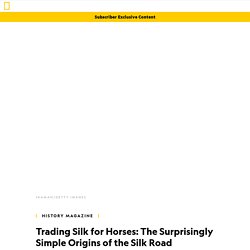
The art of turning the cocoons of the silkworm moth (Bombyx mori) was, according to legend, discovered by the wife of the Yellow Emperor, a mythical forebear of the tribe that later founded China’s first dynasty, the Xia, in circa 2070 B.C. While she was drinking tea in the shade of a mulberry bush, a cocoon fell into her cup. Instead of throwing it away, she examined it and discovered that pulling on a strand could completely unravel it. Traditionally, silk production was entrusted to Chinese women and carefully guarded as a state secret. Revealing the confidential methods of sericulture was punishable by death.
In the 19th century German geographer Ferdinand von Richthofen looked for a term to describe the trade routes that shuttled silks and other luxury goods between the Far East and the Mediterranean from the first century B.C. until the Middle Ages. Did the Great Wall of China work? Lesson Plans on East Asia. Lesson Plans on East Asia Geography: East Asia in Geographic Perspective Every section or topic has lesson plans History: CHINA specific: JAPAN specific: Religions: Art Online Museum EDUCATIONAL Resources in Asian Art [OMuERAA] Lessons for all educational levels Search by art form, country, time period, religion or by “featured topic” Literature Texts and Contexts: Teaching Japan through Children’s Literature [Program on Teaching East Asia (TEA), University of Colorado] East Asia Gateway for Linking Educators/ EAGLE – Lesson Plans [U of Pittsburgh) National Consortium for Teaching about Asia [NCTA] – State Sites Many seminar and state partner sites of NCTA offer lesson plans developed by teachers in their programs.
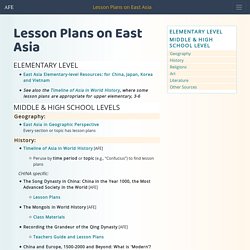
Search for Asia related lessons on these excellent sites: Living in the Chinese Cosmos. Your Guide to all things Chinese. Grand Canal System. Source: adapted from Delfs, R. (1990) "Arteries of the Empire", Far Eastern Economic Review, 15 March 1990, pp. 28-29 The Grand Canal system (or Da Yun He) represents a remarkable achievement of imperial Chinese hydraulic engineering.
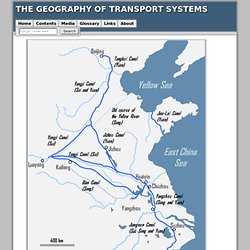
At its peak during the Ming dynasty (1368-1644 AD), the system totaled about 2,500 kilometers with Beijing at its northernmost extension, Hangzhou at its southernmost point and Luoyang at its easternmost point. Smithsonian Learning Lab. This collection contains information and teaching resources on the Terracotta Army, a group of approximately 7,000 life-size terracotta figures created for the tomb complex of China's First Emperor, Qin Shihuang (259 – 210 BCE).

Resources in this collection cover a wide range of topics, including: the discovery of the Terracotta Army, Emperor Qin Shihuang, the unification of China, Qin dynasty (221 – 206 BCE) spiritual beliefs, how the terracotta warriors were made, the different types of terracotta warriors, and the types of bronze weaponry found in the Terracotta Army pits. This collection also contains three interactives: a timeline of ancient Chinese history, a map of the tomb complex, and maps of battle formations in the Terracotta Army pits.
Authors of this collection are the Emperor Qin Shihuang’s Mausoleum Site Museum, the Smithsonian Center for Learning and Digital Access, and the Smithsonian’s Freer Gallery of Art and Arthur M. Sackler Gallery. Early Chinese Bronzes. Content created: 130715File last modified: 150621 A Beginner's Guide Page Outline.
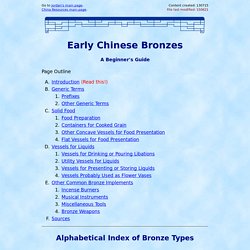
Chinese History And Culture. What makes the Great Wall of China so extraordinary - Megan Campisi and Pen-Pen Chen. The incredible history of China's terracotta warriors - Megan Campisi and Pen-Pen Chen. Ancient China. Who was Confucius? - Bryan W. Van Norden.
Qin Dynasty 秦朝. Táng Dynasty 唐朝. Sòng Dynasty 宋. Yuan-Mongol 元朝. Qīng-Manchu Dynasty 清朝. Late Imperial Period. Silk Road 丝绸之路. 清明上河图. Ancient China. Taoism. Zhuangzi. Daoist Philosophy. Along with Confucianism, “Daoism” (sometimes called “Taoism“) is one of the two great indigenous philosophical traditions of China.
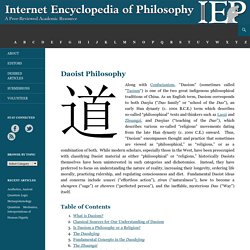
As an English term, Daoism corresponds to both Daojia (“Dao family” or “school of the Dao”), an early Han dynasty (c. 100s B.C.E.) term which describes so-called “philosophical” texts and thinkers such as Laozi and Zhuangzi, and Daojiao (“teaching of the Dao”), which describes various so-called “religious” movements dating from the late Han dynasty (c. 100s C.E.) onward.
Thus, “Daoism” encompasses thought and practice that sometimes are viewed as “philosophical,” as “religious,” or as a combination of both. While modern scholars, especially those in the West, have been preoccupied with classifying Daoist material as either “philosophical” or “religious,” historically Daoists themselves have been uninterested in such categories and dichotomies. Table of Contents 1. 2. 3. 4. 5. The term Dao means a road, and is often translated as “the Way.” 6. 7. 8. 9. 10.